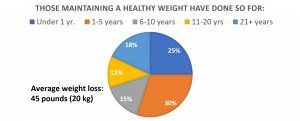A Historical Perspective of Overeaters Anonymous
The first Overeaters Anonymous meeting was held in 1960 in Los Angeles, California. Since that time, OA has grown to over 6,400 meetings in more than 80 countries with approximately 54,000 members and growing.
Disordered Eating in the US
In light of the most recent (2017-2018) statistics from the Center for Disease Control and Prevention (CDC), the prevalence of obesity was 42.4%. From 1999–2000 through 2017–2018, the prevalence of obesity increased from 30.5% to 42.4%, and the prevalence of severe obesity increased from 4.7% to 9.2%.
Obesity-related conditions – some of the leading causes of preventable premature death – include:
- Heart Disease
- Stroke
- Type 2 diabetes, and
- Certain types of Cancer
The estimated annual medical cost of obesity in the United States was $147 billion in 2008 US dollars; the medical cost for people who have obesity was $1,429 higher than those of a normal weight.
2019 Adult Obesity Prevalence Maps
The CDC has released the 2019 Adult Obesity Prevalence Maps for 49 states, the District of Columbia, and 2 US territories. The maps show self-reported adult obesity prevalence by race, ethnicity, and location.
What the 2019 maps came to reveal is that obesity impacts some groups more than others. There are notable differences by race and ethnicity, as shown by combined data from 2017-2019:
- 6 states had an obesity prevalence of 35% or higher among non-Hispanic White adults.
- 15 states had an obesity prevalence of 35% or higher among Hispanic adults.
- 34 states and the District of Columbia had an obesity prevalence of 35% or higher among non-Hispanic Black adults.
According to the World Health Organization (WHO), obesity has reached epidemic proportions globally – at least 2.8 million people dying each year as a result of being overweight or obese.
According to the CDC, within the US alone, this “epidemic” results in 400,000 annual deaths – more deaths than that caused by alcohol and drugs combined!
Regrettably, marginalized populations are hardest hit by our disease.
- By example, non-Hispanic Black adults (49.6%) had the highest age-adjusted prevalence of obesity
- Hispanic adults (44.8%)
- Non-Hispanic White adults (42.2%)
- Non-Hispanic Asian adults (17.4%).
Among adults aged 20 to 39 years, the prevalence of obesity was 40.0%, whereas it was 44.8% among adults aged 40 to 59 years, and 42.8% among adults aged 60 and older.
Adding to these dire statistics is the impact of the current pandemic. At the National Eating Disorders Association Hotline calls are up 70-80%.
- For many, eating is a form of control – a coping mechanism tied to stress.
- Food scarcity and stockpiling behavior can trigger anxieties about eating or overeating.
- Eating disorders are highly isolating – social distancing only exacerbates this problem.
Of anorexics in the US, 62% experienced a worsening of symptoms after the pandemic hit. With the far more common binge-eating disorder, in America nearly a third reported an increase in episodes.
And, tragically, eating disorders have the second-highest mortality rate of any psychiatric diagnosis – outranked only by opioid use disorder!
In light of these dire statistics, at OA Silicon Valley we realize today, more than ever before, that our primary purpose – to help the still suffering compulsive eater – is more vital than ever before!
Overeaters Anonymous 2017 Survey – a look at our Members
Before coming to OA, 77% of members received some type of treatment or counseling, such as medical, psychological, or spiritual. Of those members, 30% said it played an important part in their coming to OA.
After coming to OA, 67% received some type of treatment or counseling, such as medical, psychological, or spiritual. Of those members, 88% said that support from OA has been helpful in conjunction with treatment or counseling. Many of our members in recovery from compulsive eating have maintained a healthy weight for more than 5 years, with other having done so for several decades!

If you’d like to see the complete details from our 2017 membership survey, please click here!
If you are curious about how Overeaters Anonymous Silicon Valley can help the patients, clients, students, staff, or community members you serve – then isn’t it time you got to know OA? Please send email to pro-outreach@oasv.org for further details.
At Overeaters Anonymous Silicon Valley, we help anyone and everyone who is struggling with anorexia, bulimia, binge eating, obesity, over-eating, under-eating, nighttime eating, excessive exercise, poor body image, or any number of other food issues and compulsive eating behaviors.
